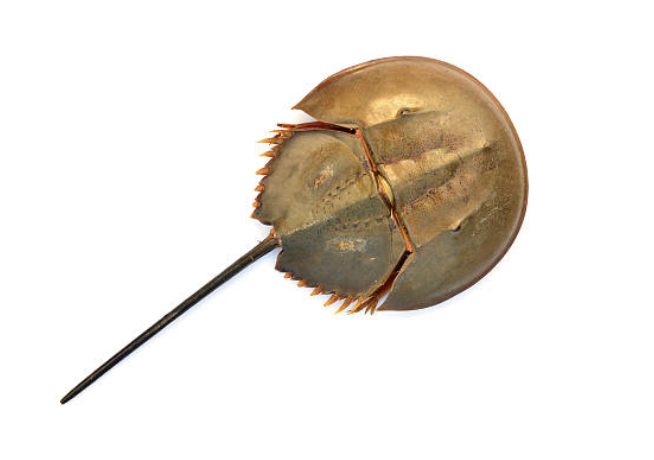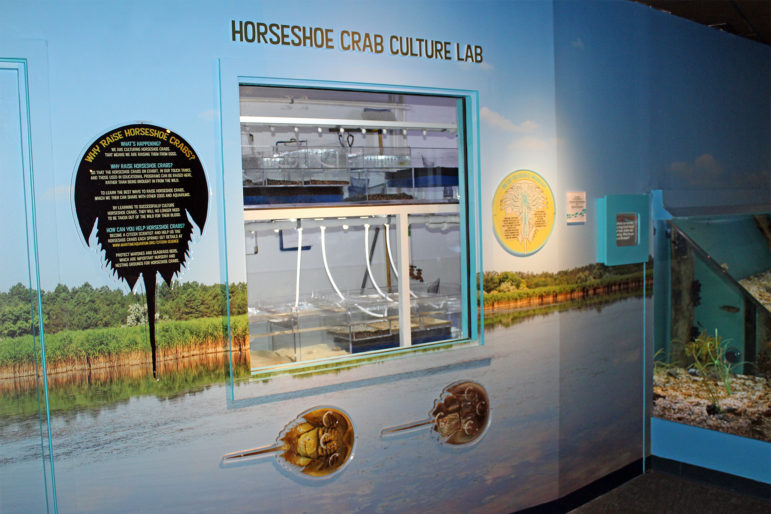Horseshoe Crabs
HORSESHOE CRAB: Limulus polyphemus
The horseshoe crab has a distinctive shape consisting of head, thorax and telson (sometimes prosoma, opisthosoma and telson). These same names are used to describe different parts on other animals. Though there has some been some question among biologists about which Class of animals they should be placed with, horseshoe crabs, in evolutionary terms, are most closely aligned to the lines that became spiders and scorpions.
There are six pairs of appendages. The first, the chelicerae, are located ahead of the mouth and bristles, four are for walking, the last for pushing. The toes of the male's second pair have been modified by the addition of large muscles or claspers that are used during spawning. Males do not have claspers until they are six years old.
Range: There are four species of horseshoe crabs. The Atlantic horseshoe crab exists along the Atlantic coast from Maine to Yucatan. From Georgia to Delaware Bay is the center of the range and here the animals are bigger and more abundant. Cape Cod bay also supports a notably large population. In winter Limulus inhabits deep water off the Atlantic coast or in bays, coming ashore to spawn on protected beaches only when the water is warm enough.
The other three species of horseshoe crabs are found only in the Indo-Pacific region.
Age: Horseshoe crabs may live to 18 years, but this is unusual; 14 or 15 years is more likely.
Diet: Limulus eats worms, larval animals, eggs and carrion as well as some algae. It also eats small mollusks such as hard and soft clams that can be cracked between the bases of the pushers (sixth pair of legs). Softer materials are broken up by the bristles at the bases of the first four pairs of walking legs. The animal also ingests bits of shell and sand which act as grinders inside the gut. The hard materials may be expelled through the mouth. Soft waste passes through the gut and is expelled through an anus located at the base of the muscle that controls the telson.
Size: When they mature fully, females may measure 24" across. Males at every age are smaller than females and may never reach half that size. As noted below, the larva molts three times inside the egg and twice more outside. In the second year there are three molts, two in the third year, one in the fourth and one annually thereafter until quite old. If you pinch gently inside one edge, you can feel that recently molted shells are leathery and flexible while older ones are hard and stiff.
Behavior: Limulus behavior that would be voluntary in humans and many other animals is modulated by circadian rhythms or internal clocks. For example, the compound eyes can become more sensitive at night than in daylight because of circadian rhythms. Migration to and from deeper water is a similarly programmed activity. Research on circadian rhythms is taking place at Woods Hole Oceanographic Institute.
Vision: Limulus sees movement with its lateral compound eyes, but does not make a sharp image. Under water it can distinguish between a rock and another horseshoe crab within three feet. The eyes may be 1,000,000 times more sensitive at night than during the day. The ocelli, pigmented spots on either side of the small boss near the center front of the head (prosoma) can see ultra-violet light.
Ultra violet helps the horseshoe crab to adjust the accuracy of its internal clocks. Light sensitive cells in the tail have nerve connections to the brain, but cannot be located visually on the surface.
Reproduction: Spawning: Limulus males reach sexual maturity at about 9 years, females a year later. Eggs may be laid any time between April and August, depending on the water temperature. The animals leave deep water and head for the beaches. Spawning activity peaks at night at times of full and new moons when water rises highest on the beach. Fertile males will clasp unattended fertile females and remain until eggs have been deposited in a nest. More than one male may clasp in a train.
Egg Laying: Females hold their eggs beneath the gill plate cover (the operculum) until they release them in the nest. Eggs are laid under water or in damp sand. The favored location for excavating nests depends on how high the tide rises and the geometry of the beach. Large females may deposit 2000 eggs at a time and may make more than one nest on the same day, or may lay at other times and in other locations.
Fertilization: Males release sperm into the water. Since there are many unattached, sexually excited males when eggs are being laid, sperm released in the water by the primary male and others is washed over the nests by wave action.
In the laboratory, eggs take about 45 days to hatch at a temperature of 60° F and about 25 days at Length (including telson)
72° On the beach, eggs hatch in 13-15 days. The egg has two coverings. The chorion or tough outside layer protects the egg in the sand, but breaks as the embryo grows. There are three (some say four) molts inside the egg, the shed parts being absorbed and reused. The greenish eggs measure about 1/16" when laid and grow to about 1/8" by the time the inner case breaks and the animal becomes free-swimming.
Predation: Horseshoe crab eggs are eaten by many animals as soon as they are laid. Gulls, sandpipers, fish, crabs, sea stars, snails, all gorge on the eggs either in the nest or when washed out into the water. In particular the Red Knot, a sandpiper, flies 3500 miles from Brazil to arrive for a feast of 135,000 or so horseshoe crab eggs before flying an additional 2500 miles north to its Canadian nesting grounds. [On its return flight in August and September, the Red Knot stops in James Bay, Canada for burrowing clams, in Massachusetts for mussel spat in the weed and peat beds, and in hospitable areas in New Jersey as well.]
Growth: First Year: Once out of its egg in its first swimming stage the animal is described as trilobite. It looks similar to the fossil animals of that name. The trilobite is transparent, swims mostly on its back and measures about 1/8" across. Its eyes are on the underside just in front of the mouth. After about three weeks Limulus enters its first juvenile stage, but this may be delayed much longer. It will have grown to about 3/16" and have a short tail (telson) and a translucent shell. It may spend part of its time walking and may also begin to burrow in the bottom. In the second juvenile stage the telson becomes longer and pigmentation begins. Around Cape Cod most Limulus reach this stage by the end of summer, and burrow deep for the winter.
Second Year: The animal may be expected to molt three times during this year, each time with more pigment in the new shell. While it will continue to swim mostly on its back, the ventral or underside eyes, being now covered with pigmented shell are no longer useful . When it buries itself for the second winter it will measure 11/4 " wide and 2 1/8" long.
Third Year and Thereafter: Size increases about 1/4 to 1/3 at each molt so that at the end of the third year the breadth will be 11/2 ", length 2 3/4" and at the end of the fourth year 13/4" and slightly over 3" respectively.
Both sexes measure about the same for the first few years as shown below:
Limulus blood cells contain hemocyanin, a copper bearing molecule. Hemocyanin is blue when oxygenated, colorless when oxygen-free. Human blood that contains iron, not copper, is red when oxygenated. A chamber surrounding the heart contains about 25% of the animal's blood supply. This chamber can be drained and the blood collected without harm. The blood is replaced in due course. Collected horseshoe crab blood is treated (lysed) to rupture the blood cells (amebocytes). Solid materials are discarded and the liquid remainder is dried. The product (the lysate) is a white powder. Limulus Amebocyte Lysate indicator forms clots with gram negative bacteria thereby acting as a sensitive, rapid test for the presence of endotoxins which, in human blood, can cause potentially fatal high fevers and infections.
HORSESHOE CRAB CULTURE LAB: Located in Long Island Sound Gallery adjacent to the intertidal touch tank.
We are raising horseshoe crabs from eggs so that the animals on exhibit, in our touch tanks and those used for our educational programs won't have to be brought in from the wild.
As we learn the best ways to raise horseshoe crabs, we can share that information with other zoos and aquariums.
By learning to successfully culture horseshoe crabs, there will no longer be the need for them to be taken out of the wild for their blood.